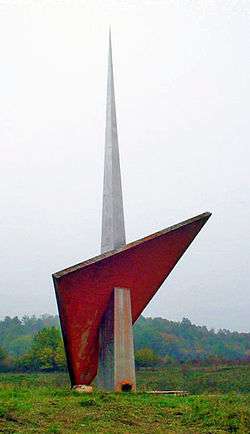Slabinja
| Slabinja | |
|---|---|
| Village | |
|
Monument to fallen fighters and victims of fascism from Slabinja | |
 Slabinja Location of Slabinja within Croatia | |
| Coordinates: HR 45°12′17″N 16°41′55″E / 45.20472°N 16.69861°ECoordinates: HR 45°12′17″N 16°41′55″E / 45.20472°N 16.69861°E | |
| Country |
|
| Region | Banija |
| County |
|
| Municipality | Hrvatska Dubica |
| Area | |
| • Total | 17.89 km2 (6.91 sq mi) |
| Elevation | 113 m (371 ft) |
| Population (2011) | |
| • Total | 348 |
| • Density | 19/km2 (50/sq mi) |
| Time zone | CET (UTC+1) |
| • Summer (DST) | CEST (UTC+2) |
| Area code(s) | 044 |
Slabinja (Serbian Cyrillic: Слабиња) is a village in central Croatia in the Sisak-Moslavina County. According to the 2011 census, the village had 348 inhabitants in 119 family households. It is located in the Banija region, near the border with Bosnia and Herzegovina.
Geography
Slabinja is situated in the valley of the river Una, in the Petrinja-Dubica Downs microregion in central Croatia, 9 kilometers northwest of Hrvatska Dubica. It is connected by the D47 highway.[1]
The main economic activities are agriculture and livestock.[1]
Religion
In the Serbian Orthodox Church administrative division Slabinja belongs to Kostajnica-Dvor Parsonage at Eparchy of upper Karlovac.[2] In the Roman Catholic Church administration belongs to the Holy Trinity Parish from Dubica, Dubica-Kostajnica Deanery of Diocese of Sisak
Serbian Orthodox Church
On the south side of the D47 road, towards the river Una, are the ruins of the Church of Saint Parascheva. The Church was built in 1828. In 1944, during World War II, it's mined by the Ustasha damaging roof structure, vault, interior and church inventory. After World War II ruins remained standing. In 1970 began the reconstruction of this valuable buildings, but roof, unfortunately, was never set up. The Church is located in the center of village.[3]
History
In the late 19th and early 20th century, Slabinja was in Kostajnica district in the Zagreb County of the Kingdom of Croatia-Slavonia within the Austro-Hungarian Empire. From 1929 to 1939, Slabinja was part of the Sava Banovina and from 1939 to 1941 of the Banovina of Croatia within the Kingdom of Yugoslavia.
During SFR Yugoslavia (1945–1991) Slabinja was part of large municipality Kostajnica, SR Croatia.[1] During the Croatian War (1991–1995), the village was part of the Republic of Srpska Krajina.
Slabinja got electricity in 1963 and the road is asphalted in 1971.[4]
Monument to fallen fighters and victims of fascism from Slabinja during World War II in Yugoslavia was built in 1981.[4] The monument was unveiled on 30 May 1981.
Demographics
In 1991, the village had 523 inhabitants:
- Serbs - 458 (87,57%)
- Yugoslavs - 42 (8,03%)
- Croats - 12 (2,29%)
- Others and unknown - 10
Notable people
- Milka Dudunić (1939),[5] wife of former Croatian President Stipe Mesić
- Zdravko Kolar (1923–2008), Yugoslav Partisan
- Pero Kovačević (1957), Croatian lawyer and politician
- Mirko Mećava (1929), Croatian anti-fascist
- German Opačić (1857–1899), Serbian Orthodox bishop
See also
References
| Wikimedia Commons has media related to Parascheva of the Balkans. |
- 1 2 3 Leksikon naselja Hrvatske, 2nd Volume, Mozaik knjiga, Zagreb, 2005
- ↑ "Eparchy of upper Karlovac". Retrieved April 9, 2015.
- ↑ Kulturno-historijski spomenici Banije, Filip Škiljan, Zagreb, 2008, page 99
- 1 2 Đorđe Đueić, Epitaf kraj zelene rijeke, Kostajnica 1981
- ↑ "Milka Mesić Biography". Večernji list. Retrieved April 10, 2015.
